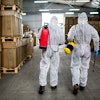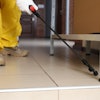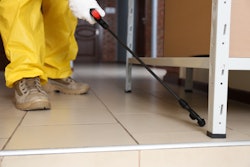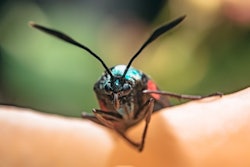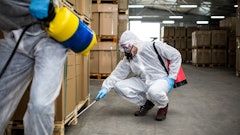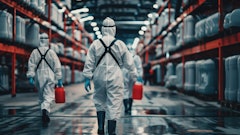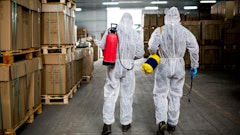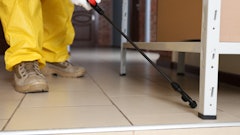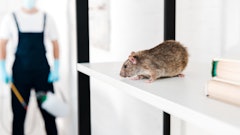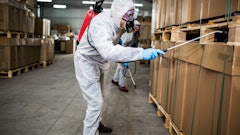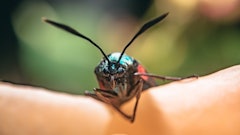
The production of high-value healthcare cannabis products requires adherence to high-quality standards. This includes the use of organic production practices and maintenance of stringent purity standards. Producers of these products are intensely focused on achieving and maintaining these high standards, both to meet their ethical obligations and to defend the future of the industry. That means you, as a partner in the distribution chain for these products, need to be just as focused in order to avoid reducing the quality or value of these products and to maintain the trust of the producers of these valuable products. These valuable and sensitive cannabis products should be thought of in the same terms as pharmaceuticals, especially when addressing potential pest issues.
Why pest management is critical
Pests in warehouses and transport conveyances can greatly affect both the actual and perceived quality of cannabis products. Contamination of products by the feeding or nesting of pests has obvious impacts. The occurrence of pests in the packaging containers or wrapping of products can also have significant consequences, even if the pests don’t actually contaminate the products. The perception of potential contamination is enough to cause reductions in value, along with loss of trust, reputation and business.
Logistics partners may also have some liability if this occurs, if it is determined that the pest infestation or trapping in packing material happened during the storage or transport of the product. Even without actual financial liability, the loss of trust with the customer is often serious enough to have an impact of the success of a business relationship.
What are the risks
Pests that can occur in warehouses or transport include:
- Various species of cockroaches are well adapted to live around humans and can be quite comfortable in the right conditions in warehouses, trailer vans, shipping containers and packaging. Small infestations can quickly become large infestations even in the best maintained facilities because cockroaches can be brought into the facility on packing material, especially paper products, or by employees bringing them in from their homes.
- Flies can breed inside warehouses under the right conditions or be drawn into buildings during packing and shipping operations, ending up in the packages. The most common situation in warehouses is entry through open doors during loading or unloading operations. If the warehouse has a pallet shrink-wrapping operation, flies can be trapped in the pallet wrap. Customers receiving pallets with flies in the wrapping may consider the product contaminated and refuse delivery.
- Common mice and rats, either roof or Norway rats, can be found living in and around warehouse and shipping facilities. These animals are quite adaptable and can make a living feeding on and nesting in storage areas, packing materials or the product itself. Rodent tracks, gnaw marks or rodent droppings in shipped material can be the cause for refusal of delivery. Rodents can chew into product containers and contaminate product directly.
- Psocids are small, soft bodied insects that need high humidity environments to thrive. While not common, their populations can reach extraordinary levels under the right conditions and directly contaminate products or get trapped in packaging leading to the perception of contamination.
- Termites feed on cellulose and can swarm in warehouses leading to loss of packaging material, or the need to repackage product. No one wants their product packed in damaged material.
- Birds can enter and roost or even nest in large warehouses, contaminating product and packaging with their waste. Bird waste can transmit bacteria such as salmonella, which can be a risk for warehouse workers.
- There are a number of stored product pests that specialize in feeding and breeding in dried plant material. Infestations can be hard to control and often result in the need to destroy the infested product.
- In some areas seasonal pests such as cluster flies, ladybird beetles or marmorated stink bugs can occur around warehouses in large numbers at certain times of the year. As with other insects, if these get trapped in packing material, the product will be perceived as contaminated and unacceptable.
How to manage these risks
The most successful approach to managing risks from these pests is the use of a system known as integrated pest management (IPM). IPM is recognized as the preferred approach to managing pest risks in many industries, including pharmaceuticals and healthcare facilities. IPM is used by pest management professionals throughout the warehousing and logistics sector as well.
In practice, IPM means:
1. Identifying the problem
2. Determining the acceptable level of risk or damage
3. Establishing an action threshold
4. Identifying appropriate control methods and practices
5. Integrating these control methods to manage the pests
For the logistics sector, control methods include:
- Physical controls. Tight door seals, air curtains, screens, rapid close doors, dock leveler seals and other pest exclusion practices.
- Cultural controls. Sanitation, routine maintenance and policies that reduce pest risks such as keeping doors closed, inspecting material before acceptance and others.
- Biological controls. Pheromones, mating disrupters.
- Chemical controls. Insecticides approved for use in pharmaceutical production and warehouse facilities; rodenticides acceptable for use on the exterior of these facilities.
When these control methods are used in an integrated manner, pesticides are used sparingly and only when other controls are not being successful. Many facilities will go for extended periods without requiring any pesticide use.
IPM depends on routine inspection and monitoring for pests, and the maintenance of the physical and cultural controls that are the foundation of a good pest management program. Monitoring uses specialized pest monitoring devices such as multi-catch rodent traps, insect monitoring boards, insect light traps, and pheromone traps, as well as comprehensive inspections. Reports on pest detected are analyzed to see if pests are reaching unacceptable levels, and then appropriate control measures are strengthened or implemented. For example, if an insect light trap detects a sudden increase in midges entering from the exterior in one part of a facility, this may indicate a failure to keep doors closed, or a malfunctioning air curtain.
It is not necessary or advisable for logistics experts to attempt to be IPM experts. That’s why it’s important to partner with a pest control provider that can help keep your products protected. Your provider should be an expert in IPM and routinely protect quality standards in the food processing, warehousing and pharmaceutical industries. With help from your pest control partner, you can decrease potential risks that pests cause and rest assured you are prepared for any issues that come up.


